CLICK ON IMAGES TO ENLARGE
The worst-case scenario is happening now
An evaluation of recent academic work on ongoing and regional climate change impacts and the latest future projections.
By Bruce Melton | The Rag Blog | February 16, 2012
(This article is an expansion of and provides technical backup for Bruce Melton’s three-part series, “Welcome to Climate Change in Texas,” published in December 2011 and January 2012 on The Rag Blog.)
AUSTIN, Texas — If this is not dangerous climate change, then this is exactly what dangerous climate change will be like in as little as a decade. What has been happening in Texas, with its unprecedented (in time frames that matter) droughts and wildfires, is exactly what the climate scientists have been warning us about for over 20 years. We have been building up to this point since about the turn of the century, and now ecosystems have tipped over the edge. Climate feedbacks have kicked in hard.
The Texas Forest Service tells us that a half billion trees have died. The first of this series of droughts in 2005/6 was just classified as extreme. The last two have been one category worse than extreme — the exceptional category. The last 12 months were drier than the worst 12 months of the great drought of the 1950s. This has been a $10 billion drought, with another $1 billion in damages from the fires.
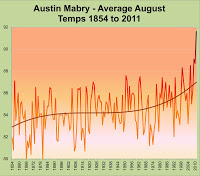 Worse, it’s hotter now. This past summer was 5.4 degrees warmer than average. This may not seem like a lot, but think how sick you would be if you had a 104 degree temperature.
Worse, it’s hotter now. This past summer was 5.4 degrees warmer than average. This may not seem like a lot, but think how sick you would be if you had a 104 degree temperature.
The reason that increased heat makes such a big difference in a drought is that extra heat greatly increases evaporation. Four percent more water evaporates for every degree of temperature increase. With 5.4 degrees of warming above average, summertime evaporation in Austin was more than 22 percent greater than normal. In other words, the same drought is much worse if it is only a little hotter.
In the same breath, even with normal rainfall, because of warmer temperatures, drought can persist because of much greater evaporation. The warmer temperatures are easy to see looking at the average August temperature for the period of record.
It is important to talk about the urban heat island effect here too. The chaos of information presented by our media today does little to shed light on the latest climate science. An evaluation of regional temperature departure from normal for 2011 shows the exceptional nature of this most recent in a string of droughts.
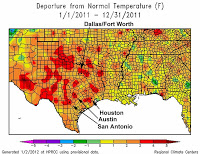 Urban heat island signatures are easily evaluated and constant correction is an integral part of climate work on global land/ocean temperatures. Corrections are made through the comparison of individually impacted weather stations and their normal neighboring rural weather stations.
Urban heat island signatures are easily evaluated and constant correction is an integral part of climate work on global land/ocean temperatures. Corrections are made through the comparison of individually impacted weather stations and their normal neighboring rural weather stations.
Published work on the heat island effect shows that even without correction, the heat island’s influence on global temperatures is as yet inconsequential because of the relative size of the heat islands compared to the global surface.
The evaluations can also be visually confirmed looking at the temperature departure from normal for the region during the 2011 drought. Where the heat island effect looks to be dramatically visible in the Austin and San Antonio metropolitan areas, it is dramatically absent from the Houston and Dallas metro areas.
The total number of fires in Texas since November 2010 (through September 20, 2011) is 22,790, totaling 3,759,331 acres. This exceeds the previous record of 2.1 million acres, set in just 2005/6, by 80 percent. We almost doubled the last record, set just five years ago.
Thirty-three percent of U.S. wildland fires in 2011 were in Texas. This number is 61 percent greater (as of September 2011) than the 10-year national average for the entire United States. Six of the 10 largest wildfires in Texas history occurred in 2011.
Sure, there have been bigger droughts and bigger fires in the early 1900s or the 1800s or the 1300s, or 3,000 year BC, but our complicated society did not evolve back then. We do not have the water to support our region today. This is why we have water use restriction in effect now, and last summer and every summer since the turn of the 21st century.
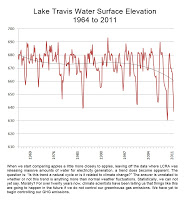
 It cannot be emphasized more that this is exactly what our climate scientists have been warning us would happen for the last 20 or 30 years. Only their warnings were generations distant from actual impacts happening today. The impacts happening now are far ahead of the projected schedule. The reason is that the projected future climate changes have always been based on the middle of the road “Kyoto” suggested emissions behaviors.
It cannot be emphasized more that this is exactly what our climate scientists have been warning us would happen for the last 20 or 30 years. Only their warnings were generations distant from actual impacts happening today. The impacts happening now are far ahead of the projected schedule. The reason is that the projected future climate changes have always been based on the middle of the road “Kyoto” suggested emissions behaviors.
Our society has not limited our emissions as was suggested by climate scientists to be a prudent way of avoiding dangerous climate change. What should have been a global emissions path reduction to a few percentage points less than the emissions made in 1990 has instead seen emissions grow to 50 percent greater than they were in 1990.
Climate scientists warned us that if we did not significantly limit our emissions, our climate would change much faster, with much greater risks of even larger changes duo to positive feedbacks that we were just beginning to understand.
Since the IPCCC stopped taking papers for the 2007 report in 2005, we have learned a lot about these feedbacks. We have also been able to document changes to our climate happening much faster than previously projected and these two things are, as suggested by our climate scientists for a generation or more, intimately related.
In June 2009, the U.S. Global Change Research Program (USGCRP), founded by Ronald Reagan, published a report that tells us that by 2080, Austin will see an average of 90 to 120 days of 100 degree weather every year — 10 times more than today’s average of 12 days per year.
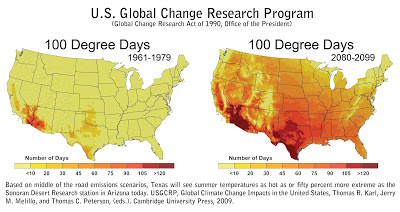
Look Closely at Arizona. The area of the map with 100 degree day data from the 1961-1979 data can be considered to be representative of the average for the 20th century. What the USGCRP tells us is that enormous areas of the North American continent will see the same climate that has seen the evolution of the Saguaro Cactus, in the Sonoran desert of South Central Arizona or in many cases, a climate that is up to 50 percent more extreme than that of the Sonoran Desert today.
But the most mind-boggling part of this future projection is that it is based on the IPCC A1B scenario. This is one of the middle of the road emissions scenario families where our society makes a modest effort to reign in greenhouse gas emissions. It is loosely based on a path that could be represented by efforts with the Kyoto protocol where new efficient technologies are rapidly put into use and there is a balanced emphasis on all energy sources. For decades it has been considered to be the most likely scenario of actual emissions.
But this thinking is enormously dated. We are currently smack-dab in the middle of the worst-case scenario considered by climate models. Even with the economic recession, global carbon emissions in 2010 were double the recent average and as high as anything seen since the late 1970s/early 1980s.
Let me repeat one more time: The USGCRP projections are based on the middle of the road scenario. We are currently on the worst-case scenario path. This means that temperature change will be more to significantly more than we have been expecting for decades. And this is one of the main reasons why our climate has already changed so much, so rapidly and why future change will be even faster than projected.
 This middle of the road scenario is also considered in the next two examples of climate projections as well. It is very clear from discussions of these results by the principal investigators in their research papers that these results are conservative and the future is very likely to see changes that are greater than what are indicated.
This middle of the road scenario is also considered in the next two examples of climate projections as well. It is very clear from discussions of these results by the principal investigators in their research papers that these results are conservative and the future is very likely to see changes that are greater than what are indicated.
A paper in Geophysical Research Letters in July 2010 by two researchers from Stanford and Purdue (Diffenbaugh and Ashfaq) tells us that climate conditions will continue to rapidly worsen in the interior of North America and especially the West. The worsening will be so rapid that in Central Texas the current decade of 2010 to 2019 will see two to three droughts as bad as or worse than the drought of the 1950s.
Beginning in just 8 years, in the decade 2020 to 2029, Central Texas will see four to five droughts as bad as or more extreme than the drought of the 1950s. The implications of these projections are staggering. And remember, these projections are based on the middle of the road scenario. It is quite likely that changes will be even greater than what these Stanford researchers suggest.

A report out of the National Climatic Data Center in February 2011 (Dia) tells us that beginning in just 19 years (2030) Dust Bowl conditions will be the average climate condition across much of the interior of the U.S. By 2060, much of the interior of the nation will be two to three times as bad as the Dust Bowl with some areas four to five times more extreme than the Dust Bowl.
The 20-year projection is sobering. What is depicted here is the average condition. Across much of the United States, the average drought condition will be similar to that of the Dust Bowl. It is very important to understand that these findings indicate the average condition. Some years will be worse, but on average, it will be as bad as the Dust Bowl — continually — and in some areas four to five times as bad as the Dust Bowl.
What is most important to remember about exceptionally extreme events such as these is that it is the most extreme events that do the most damage. Climate change increases the occurrence of these most catastrophic of events. As the temperature increases, the number of extreme events disproportionately increases too. What this means is that a little warming increases the number of extreme events a lot, not a little.
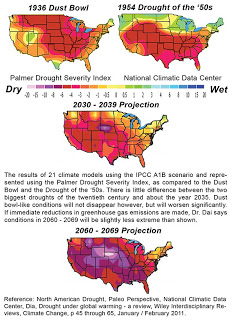 By mid-century however, we reach completely catastrophic levels of continuous drought several times more extreme than the Dust Bowl. Implication of this type of non-stop drought and adaptation strategies for these extreme conditions have simply not been contemplated in the literature. Significant work is underway to gain insight into these situations that seemed so improbable just a few years ago.
By mid-century however, we reach completely catastrophic levels of continuous drought several times more extreme than the Dust Bowl. Implication of this type of non-stop drought and adaptation strategies for these extreme conditions have simply not been contemplated in the literature. Significant work is underway to gain insight into these situations that seemed so improbable just a few years ago.
Again, I must insist on repeating that this research, like that from Stanford and the USGCRP, looks at the A1B scenario or a middle of the road climate emissions projection. In reality we are now on the worst-case path. Climate changes are almost certain to be more extreme than these studies have shown.
This is no longer business as usual. Water use restrictions will not meet this challenge alone. We must act now to convince our leaders that this is not just another in a long string of extraordinary weather events that we cannot yet blame on climate change.
If we do not immediately change our habits and lifestyles, we will run out of water. Our forests are already dying because they have run out of water. The evidence supporting the relationship between this string of unprecedented droughts and climate change is overwhelming.
A paper by Kevin Trenberth and colleagues from the National Center for Atmospheric Research, Scripps Institute, and The Weather Underground has summarized 61 different findings concerning climate changes already occurring and dating back to 1998. An example of these findings includes the Moscow Heat Wave of 2010 where over 60,000 died. The findings show that this heat wave was 80 percent likely to have been caused by climate change.
A draft paper by James Hansen, Director of the NASA Goddard Institute for Space Studies (the main U.S. climate modeling agency) tells us that the Texas drought in 2011 is significantly similar to the Moscow heat wave (only we have a lot more air conditioning in Texas, contributing to far fewer deaths). The Hansen paper speaks to the issue that, because our climate has so significantly changed, all weather now must be considered to have been caused by climate change.
Many of us have heard by now that it was much drier during the droughts of the 1600s, 1700s, and 1800s before reliable record keeping began in Texas. These droughts however, do not hold a candle to what scientists have discovered to be true “megadroughts.” Two of them happened between the 900s and about 1350. These droughts saw rainfall drop to 25 percent of normal and they lasted for centuries — hundreds of years!
Water level changes of hundreds of feet in closed basin lakes of the Great Basin show that these droughts were widespread. Hundred-year old trees growing a hundred feet or more below the current water level attest to that.
The climate also likely changed quite rapidly when rain did begin to fall again because many of these trees remain intact with their branches, submerged and semi-preserved in the cold waters. One tree in Jenny Lake at the foot of the Grand Tetons in Wyoming still has a raptor nest in it, now about a thousand years old.
There is also evidence that large portions of the Great Plains desertified during these droughts. This is one of those big things the climate scientists have been warning us about now for decades. During these desertification events, much of the Great Plains actually changed to a sea of shifting sand. This desertification was much larger than that at the turn of the 19th century that fostered the term “Great American Desert.”
Sure, there have been bigger droughts and bigger fires in the past, but our complicated society did not have 1.7 million people in the Austin/Round Rock Metropolitan Area then.
Projections of climate changes from a few decades ago have been shattered. Future projections are exceedingly stark, and these projections are based on the middle of the road scenario — far, far from where our emissions are today. Now the climate scientists are warning us of upcoming weather far more extreme than our civilization has ever experienced and to which our society will have difficulty adapting.
We must prioritize our actions towards immediate action and adaptation strategies far more rigorous than anything yet contemplated. Climate scientists continue to warn us, and their warnings continue to worsen.
Our State Climatologists has attributed only a small portion of our 2011 event to climate change. I have amassed a very large amount of data over the years looking at this issue in Central Texas and specifically the validity of the previous heat wave of record in the mid 1920s. The culmination of this work can be seen in a three part series published on an investigative internet journal the Rag Blog.
A summary of my reporting shows that the heat records of the mid 1920s are likely to be in error. This means that the 2011 heat wave was not an event that shattered the previous record by more than 30 percent. It means that the 2011 event likely obliterated the previous record event by over 100 percent. This of course means that our State Climatologists opinion of the science is significantly dated.
Even with the erroneous 1923 and 1925 heat records intact in the data, what we have just seen in Central Texas — in combination with the warnings we have been given for over two decades and the evidence showing the global trend of climate change is much faster than previously assumed — tells us that, scientifically and morally, there is no reason to doubt that climate change is not the cause.
The solutions however, will be nowhere near as expensive or “ruinous to our economies” as have been suggested by many voices reported by the media. The most recent academic evaluations of the solutions to the cleaning up climate change pollution have shown that costs will be exceedingly non-ruinous.
Many non-academic sources are also claiming that this “new energy economy” that we are embarking upon will not only be highly prosperous for humankind, but it will also be highly profitable for humankind as well. Historically, this kind of fundamental societal change is very well correlated with highly prosperous and highly profitable historic changes to our civilization. Much more on this topic is also included in the three part series mentioned above.
[Bruce Melton is a professional engineer, environmental researcher, filmmaker, writer, and front man for the band Climate Change. Information on Melton’s new book, Climate Discovery Chronicles, can be found, along with more climate change writing and outreach, critical environmental issue films, and the band’s original blues, rock, and folk music tuned to climate change lyrics at his website. Read more articles by Bruce Melton on The Rag Blog.]
- Listen to Thorne Dreyer’s December 30, 2011, Rag Radio interview with Bruce Melton.
References
A half billion trees:
Preliminary estimates show hundreds of millions of trees killed by 2011 drought, Texas Forest Service, December 19, 2011.
http://txforestservice.tamu.edu/main/default.aspx?dept=news
Urban Heat Island:
Hansen et al., Global Surface Temperature Change (heat island), Reviews of Geophysics, December 2010.
http://pubs.giss.nasa.gov/docs/2010/2010_Hansen_etal.pdf
Jones and Wigley, Estimation of global temperature trends, whats imnportant and what isn’t, Climatic Change, May 2010.
http://www.springerlink.com/content/74731m62483l72m7/
Menne et al., Homogenization of Temperature Series bia pairwise comparison, Journal of Climate, 2011.
http://journals.ametsoc.org/doi/full/10.1175/2008JCLI2263.1
Menne at.a l., The US Historical Climatology Network Monthly Temperature Data version 2, Bias Adjustment, 2011.
http://www.ncdc.noaa.gov/oa/climate/research/ushcn/
Deceitful propaganda campaigns similar to acid rain, smoking, pesticides and ozone depleting chemicals…
Oreskes and Conway, Merchants of Doubt, Bloomsbury 2010.
Billion dollar U.S. weather disasters 2011, National Climatic Data Center:
http://www.ncdc.noaa.gov/oa/reports/billionz.html
The Texas drought and future of drought in Texas:
Snapshot of the Texas Drought: Near-term and long-term, projections include more dry conditions in Texas, Texas Climate News, Houston Advanced Research Center, November 2011.
http://texasclimatenews.org/wp/?p=3548
Drought in Texas: Status, Future, Reinsurance, Willis Re, 2011.
http://www.willisre.com/documents/publications/Risk_Financing_Structuring/Resource/Property/TexasDrought_2011.pdf
August 2011 Weather Summary: National Climatic Data Center, National Oceanic and Atmospheric Administration:
http://www.ncdc.noaa.gov/sotc/national/2011/8
Worst-case scenario:
Synthesis Report, Climate Change, Global Risks, Challenges and Decisions, Climate Change Congress, International Alliance of Research Universities, University of Copenhagen, March 2009. http://climatecongress.ku.dk/pdf/synthesisreport
Raupach, et. al., Global and regional drivers of accelrating CO2 emissions, PNAS, April 2007.
http://www.pnas.org/content/104/24/10288.full.pdf+html
IPCC Special Report on Emissions Scenarios, http://www.ipcc.ch/ipccreports/sres/emission/index.htm
100 degree days:
USGCRP, Global Climate Change Impacts in the United States, Thomas R. Karl, Jerry M. Melillo, and Thomas C. Peterson,
(eds.). Cambridge University Press, 2009.Complete report available online:
http://downloads.globalchange.gov/usimpacts/pdfs/climate-impacts-report.pdf
2020 to 2029 will include three to five droughts as bad as or worse than the worst drought that we have seen since 1951:
Diffenbaugh and Ashfaq, Intensification of hot extremes in the United States, Geophysical Research Letters, August 2010. http://www.stanford.edu/~omramom/Diffenbaugh_GRL_10.pdf
Sixty-one examples of climate changes already happening:
Trenberth et al., Current Extreme Weather and Climate Change, Climate Communication.org, Science and Outreach, September 2011. http://climatecommunication.org/new/articles/extreme-weather/overview/
Hansen, Ruet and Sato, Perceptions of Climate Change: The New Climate Dice, in-press Jan 2012.
http://www.columbia.edu/~jeh1/mailings/2012/20120105_PerceptionsAndDice.pdf
Dust Bowl conditions will be the average condition beginning in 2020:
Dai, Drought under global warming – a review, Wiley Interdisciplinary Reviews – Climate Change, p 45-65, January-February 2011.
http://onlinelibrary.wiley.com/doi/10.1002/wcc.81/pdf
Megadroughts of the last 10,000 years:
Cleveland, Extended Chronology of Drought in the San Antonio Area, 2006. Tree-Ring Laboratory, Geosciences Department, University of Arkansas.
http://www.gbra.org/documents/studies/treering/TreeRingStudy.pdf
Cook, et. al., Long Term Aridity Changes in the Western United States, Science 306, 1015, 2004.
http://www.sciencemag.org/content/306/5698/1015.short
deMenocal, et. al., Coherent high and low latitude variability during the Holocene warm period, Science, June 2000.
http://www.ncdc.noaa.gov/paleo/pubs/demenocal2000/demenocal2000.html
Miao, et. al., High resolution proxy record of Holocene climate from a loess section in Southwest Nebraska, Paleoclimatology, September 2006.
http://snr.unl.edu/sandhills-biocomplexity/download/miaopalaeo2007.pdf
USGCRP History of drought variability in the central United States – implications for the future, 1999.
http://www.usgcrp.gov/usgcrp/seminars/990120FO.html

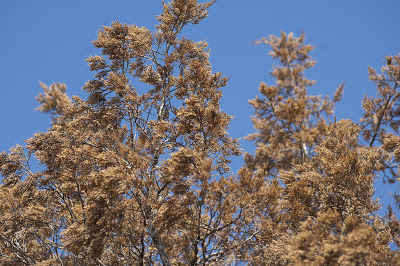

















That climate change is occurring, is obvious.
Why it occurs still seems a mystery- it would be interesting to know what factors contributed in the past before our overpopulated, oil dependant planet took hold…
Giving Bruce a well done, for the well researched article. I didn’t read the citations he provided, so I will assume for the sake of argument its all correct.
The challenge for the “lets require behavioral change to save the planet” crowd is that federal government action takes money. And when it comes to federal government money, there are only three groups of people. Those who provide it, those who dont, and those in the future who will pay for the unpaid debts we amass today.
The number of Americans who pay zero federal income tax after taking advantage of deductions and credits is now north of 45 MILLION.
The shrinking pool of us, including me, that pay far more in taxes than we receive in deductions and credits, are very wary of the next great program to save the (fill in the blank .. climate, uninsured, unemployed, etc)
This wariness is compounded when we see a government that continues to manage its finances in a way that speeds us ever faster towards an economic cliff called “cant borrow enough money to fund the government”
I spent some time at Occupy Austin and chatted with some folks there. To a person they were very worried about the climate and had ideas (some reasonable, some whacky) about how to change the climate trajectory. But when it came to finding the money needed to fund these programs, it was unanimous … “Tax the greedy rich more”
Of course, if we could somehow tax the 1% of richest Americans (based on AGI) at 100% of their income (regardless if the income was generated by wages or investment) it would raise an additional 1.1 Trillion dollars per year (2008 figures). Thats a lot, but that doesn’t even eliminate the deficit spending that exists every single year.
I would have a lot more respect for the plans and concerns of Bruce and other climate activists, if they would simply indicate they were willing to spend a lot less on other “worthy” programs in order to pay for their pet new programs. But I never hear that. I never read that. Mostly I just hear the myth that we can tax the rich more as if its some magic wand.
I, and a lot of people like me, see that the climate trajectory is not good and changes need to occur. We are willing to make some changes on this important problem. But, we find no one among the climate activists who is willing to be a partner in tackling the budget crisis we are in. So in my case at least, your concerns fall on deaf ears. Its just one more in a list of looming crisis.
– Extremist2TheDHS
Hello, Lance:
Perhaps Bruce did not articulate, but I am happy to. We need to close all overseas US military bases, stop all belligerent activities overseas, bring all the troops home, and stop funding the financial meltdown that was initiated and is being perpetuated by the banks and investment firms.
That’s not to say that the rich do not pay their fair share of the taxes. They don’t – that’s well known and documented (Winner-Take-All Politics by Jacob Hacker and Paul Pierson is a great source).
Frankly, it’s probably too late for anything in this arena with the power elite doing everything they can to maintain the status quo. Climate change is no longer anything about changing what we are doing to improve the outcome. It is now about adapting to the inevitable (very bad) outcome.
I hate it when Richard says something I actually agree with. Bring home the troops, close the overseas bases, shrink the size of and budget for the military by 75%. Use the savings to eliminate the deficit, retire the debt. Pipe dream? I think so.
One thing I learned from my time in the Tea party, is that change is also a pipe dream. No matter how many so called conservatives we elect, nothing changes. We continue to blow holes in our financial future and our constitutional liberties. Our leaders act like rulers more now than ever. This election has turned into a cage match between assclowns sponsored by SuperPAC’s and funded by a handful of the super wealthy. Voters are simply here to vote for the last man standing … thus ensuring we hold onto the illusion that we live in a democracy. My appointed job in our shared democracy is to be an ATM.
I now focus most of my energy on a homeless mission and enabling a better future for one person at a time.
– Extremist2TheDHS